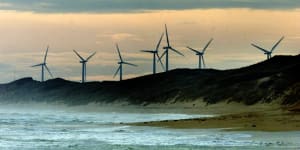The Albanese government is aiming to more than double the share of clean energy in the electricity grid to 82 per cent by 2030,to help meet legislated national emissions cuts and compensate for an approaching wave of coal-fired power station closures across the eastern seaboard.

The Albanese government is running a new scheme to reach its renewable energy goal.Joe Armao
However,there are mounting concerns in the energy industry that the target will be difficult to achieve because time is running out to build enough additional renewable generation and storage projects,as well as thousands of kilometres of new high-voltage transmission lines to connect far-flung renewable energy zones to major cities,as on their land.
Energy and Climate Minister Chris Bowen has finalised the details of a publicly funded scheme to underwrite private investment in renewables,known as the Capacity Investment Scheme.
The program,unveiled in November,targets the construction of 23 gigawatts of renewable energy generation by the end of the decade,as well as nine gigawatts of additional “dispatchable” assets,such as batteries and pumped hydro,that can store clean energy and provide it to the grid when needed.
New modelling from Melbourne-based energy consultancy Green Energy Markets calculates that 32 gigawatts of new generation – beyond what is already operating,under construction or under contract – is required to satisfy electricity demand and achieve the government’s 2030 renewable target.
Tristan Edis,Green Energy Markets’ head of analysis and advisory,said that would leave a nine-gigawatt gap that was not being filled by the government scheme.
“The national 82 per cent target for 2030 will require new investment in around 32,150 megawatts of new renewable energy projects,capable of generating around 89,258 gigawatt-hours of energy per annum,” Edis said.
“This suggests the federal government will be relying on state governments to cover the difference,or expecting a portion of projects will proceed without calling upon underwriting contracts.”
Green Energy Markets’ modelling is based on forecast electricity demand published by the Australian Energy Market Operator,and calculates the volume of electricity generation expected to come from rooftop solar panels,existing wind and solar farms and those currently being built or with an underwriting or offtake contract.
While acknowledging the 82 per cent renewables target presented a huge challenge,Bowen says it remains one that the government is confident of meeting. He said the Capacity Investment Scheme had got off to a good start. “We’re in very,very good shape on the Capacity Investment Scheme,” he said last week. “It’s going to play a very big role in our renewable energy future.”
Australia is experiencing one of the world’s fastest energy transitions as coal-fired power stations,which supply about two-thirds of the main electricity grid,increasingly bring forward their closure dates while renewable energy’s share of the mix rapidly rises.
Following the closure of AGL’s Liddell generator in NSW last year,at least another seven of the remaining 14 coal plants on the eastern seaboard are due to shut within 12 years.
AGL has brought forward the closure of the neighbouring Bayswater plant,in NSW,to no later than 2033,and has accelerated Loy Yang A’s closure in Victoria by a decade to 2035. EnergyAustralia has brought forward Yallourn’s retirement in Victoria to 2028.
Get to the heart of what’s happening with climate change and the environment.